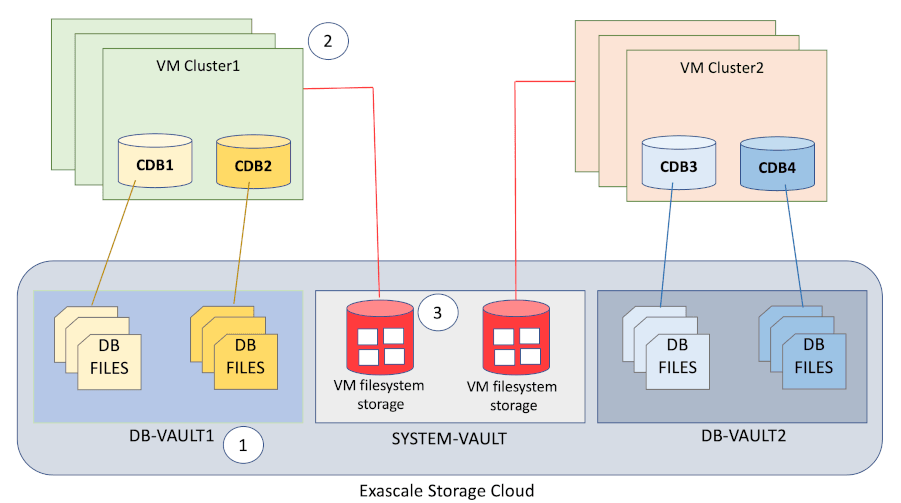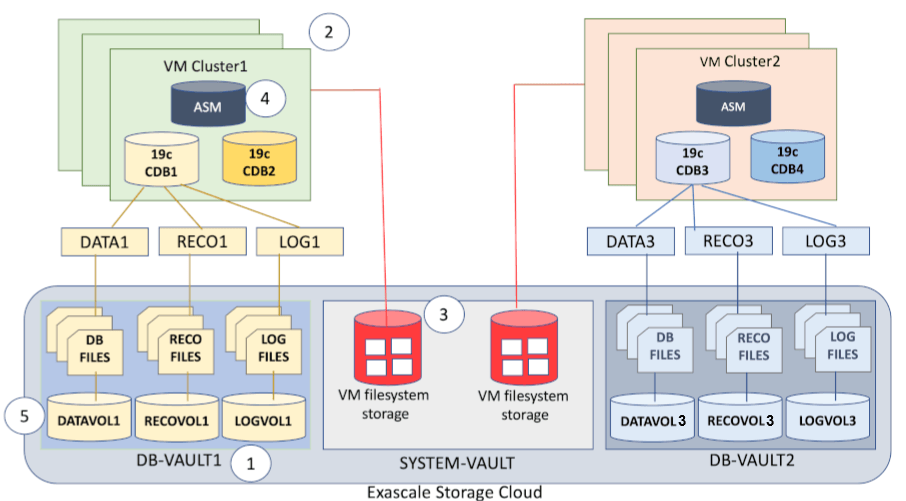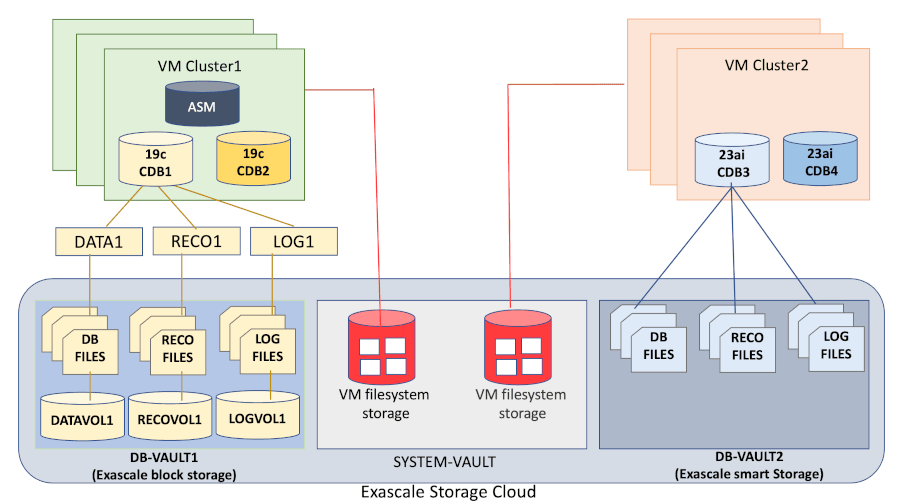Oracle Exadata Database Service on Exascale Infrastructure Overview
This topic is an overview of the Oracle Exadata Database Service on Exascale Infrastructure formerly Exadata Cloud Service.
- About Oracle Exadata Database Service on Exascale Infrastructure
Oracle Exadata Database Service on Exascale Infrastructure (ExaDB-XS) is Oracle’s newest deployment option for Exadata Database Service. - Accessing the Oracle Exadata Database Service on Exascale Infrastructure Using the OCI Console
Learn how to access the Oracle Exadata Database Service on Exascale Infrastructure (ExaDB-XS) service. - Licensing Considerations for Oracle Exadata Database Service on Exascale Infrastructure
Subscription to Oracle Exadata Database Service on Exascale Infrastructure can include all of the required Oracle Database software licenses, or you can choose to bring Oracle Database software licenses that you already own to Oracle Exadata Database Service on Exascale Infrastructure. - Supported Database Edition and Versions for Oracle Exadata Database Service on Exascale Infrastructure
Oracle Exadata Database Service on Exascale Infrastructure databases require Enterprise Edition - Extreme Performance subscriptions or you can bring your own Oracle Enterprise Edition software licenses. - Subscription Types
Learn about the available subscription types for Oracle Exadata Database Service on Exascale Infrastructure - Service Limits for Exadata Database Service on Exascale Infrastructure
Limits apply to virtual machine (VM) instance counts, total ECPU count, total local storage, and total High Capacity storage. - Metering Frequency and Per-Second Billing
See the Per-Second billing, minimums, and limitations on billing. - Exadata Cloud Management Interfaces
Oracle Exadata Database Service on Exascale Infrastructure provides a variety of management interfaces to fit your use case and automation needs.
About Oracle Exadata Database Service on Exascale Infrastructure
The What's New chapter contains the current list of regions that are available for Exadata Database Service on Exascale Infrastructure.
Exascale is the underlying technology that serves as the foundation for this service. Oracle Exadata Database Service on Exascale Infrastructure is the next generation architecture of Oracle Exadata. It increases storage efficiency, simplifies database provisioning, and combines the extreme performance of Exadata smart software with the cost and elasticity benefits of modern clouds.
Oracle Exadata Database Service on Exascale Infrastructure supports both Oracle Database 19c and Oracle AI Database 26ai. However, the Exascale implementation is different: Oracle AI Database 26ai leverages the Exascale smart storage architecture, while Oracle Database 19c uses the Exascale block storage architecture.
Oracle AI Database 26ai is tightly integrated with the Exascale Infrastructure. This integration enables direct access to Exascale storage through the Exascale Storage Vault, which eliminates the need for Oracle Automatic Storage Management (ASM). Storage for database files resides in an Oracle Exadata Exascale Storage Vault. The Storage Vault provides high-performance and scalable Exadata Smart Storage. You can scale Exadata Smart Storage online as needed, with a single command. Unlike Exadata Database Service on Dedicated Infrastructure, Exadata Database Service on Exascale Infrastructure does not require you to manage adding storage servers to the system, or to manage storage allocations.
The following schematic provides a high-level overview of the architecture of an Oracle AI Database 26ai VM Cluster and associated resources:
Figure 1-1 ExaDB-XS Oracle AI Database 26ai Architecture using Exascale smart storage
In the diagram, the architecture indicated by the numbered callouts consists of the following elements:
- A single Exascale Vault, which provides storage for the databases
- A set of VMs run on Oracle-managed multitenant physical database servers
- VM filesystems, which are centrally hosted by Oracle
Oracle Database 19c leverages Exascale block storage. This storages is comprised of Exascale Direct Volumes (EDV), and relies on ASM to manage the database storage. Each database stores its files in dedicated DATA, RECO, and LOG disk groups. During container database creation, you must specify storage allocation (in GB) for the DATA (data storage) and RECO (recovery area storage) disk groups. The LOG (redo) disk group storage allocation is automatically determined based on the number of VMs in the cluster. As with Oracle AI Database 26ai, overall storage is managed using the Exascale storage vault. You can scale this storage online, with additional storage becoming immediately available. However, in the Oracle Database 19c architecture, you must also scale storage at the individual database level by providing updated allocation values for the DATA and RECO disk groups.
The following schematic provides a high-level overview of the architecture of an Oracle Database 19c VM Cluster and associated resources:
Figure 1-2 ExaDB-XS Oracle Database 19c Architecture Using Exascale block storage
In the diagram, the architecture indicated by the numbered callouts consists of the following elements:
- A single Exascale Vault, which provides storage for the databases
- A set of VMs run on Oracle-managed multitenant physical database servers
- VM filesystems, which are centrally hosted by Oracle
- An ASM instance to manage database storage of container databases in the VM Cluster using DATA, RECO, and LOG disk groups
- Exascale Direct Volumes (EDV) for the DATA, RECO, and LOG disk groups for each container database in the VM Cluster
The following restrictions apply:
- You cannot provision within the same VM cluster both Oracle AI Database 26ai using Exascale smart storage and Oracle Database 19c using Exascale block storage.
- An ExaDB-XS VM cluster configured with Exascale smart storage cannot share a storage Vault with another ExaDB-XS VM cluster that uses the Exascale block storage.
The following schematic illustrates the architectural difference between Oracle Database 19c and Oracle AI Database 26ai.
Figure 1-3 ExaDB-XS Architecture Comparison Between Oracle AI Database 26ai and Oracle Database 19c
The basic unit of consumption in ExaDB-XS is a VM cluster. To facilitate VM portability, Exascale hosts storage for VM file systems on shared storage that is fully managed by Oracle. Oracle can migrate VMs across a pool of physical servers, because the VM filesystems that host the database binaries do not reside on local physical servers. VMs are migrated automatically as required for maintenance, or in the event of a system failure. VMs can also be scaled vertically by changing the number of Elastic Compute Processing Unit (ECPU) units, and changing VM memory allocation. An ECPU is an abstracted measure of compute resources. ECPUs are based on the number of cores elastically allocated from a pool of compute servers. You need at least 8 ECPUs per VM to provision a VM Cluster. VMs can be scaled in increments of 4 ECPUs.
In addition to Enabled ECPUs, which are active in the VM, you can also add Additional Reserved ECPUs for your VM. These Additional Reserved ECPUs are physically allocated on a physical server for future scaling of the Enabled ECPUs on your VM, so that you can scale up to meet future workload demands without requiring a restart or relocation of your VM. This option helps to control costs for variable workloads, because database licensing is based on enabled ECPUs. Also, when you reserve additional ECPUs, memory is added to the VM Cluster based on the Total ECPU count. For this reason, reserving additional ECPUs also provides a way for you to provision additional memory without the licensing expense associated with the additional cores.
The following schematic illustrates conceptual details associated with scaling CPU and memory resources:
The illustration shows the following active and reserved cores in a VM:
- Eight ECPUs, which are in use and active.
- Four ECPUs in reserve, which are guaranteed to be available, and standing by, although not in use.
- A total number of 12 ECPUs in the VM, which is the sum of Enabled cores and Reserved cores.
The total number of cores in a core reservation consists of the sum of Enabled cores and Reserved cores. To scale up your resources without restarting your systems, you can enable the reserved cores. If you want to further scale up your resources, you can add more ECPUs in units of four to your core reservation, and scale up your Enabled and Reserved cores, using a rolling restart as ECPUs are added.
Exascale also provides the benefits of redirect-on-write storage technology. With ExaDB-XS, you can provision thin clones of pluggable databases (PDBs) quickly, with space efficiency, because unchanged blocks are shared between parent and clone PDBs without being duplicated. This feature can be especially useful for development and test environments. You can create numerous thin clones of a PDB economically. For example, you can potentially give each of your developers their own PDB clone on which to work. Because Exadata Exascale has all of the performance advantages of Exadata, development environments provisioned with thin clones are representative of Exadata production environments, and not merely copies of the data.
Related Topics
Accessing the Oracle Exadata Database Service on Exascale Infrastructure Using the OCI Console
Learn how to access the Oracle Exadata Database Service on Exascale Infrastructure (ExaDB-XS) service.
When the ExaDB-XS service is enabled in your OCI Tenancy you can sign in and select your tenancy region. Then, in the services menu, navigate to Oracle Database, and then to Oracle Exadata Database Service on Exascale Infrastructure. After you navigate to the main page for the service, notice that there are two main objects for this service: VM Clusters and Exascale Storage Vaults.
VM Clusters provide the compute environment where your Oracle Database instances will run. The databases themselves, which are accessed by those Oracle Database instances, are stored in the Exascale Storage Vault. Each VM Cluster has an Exascale Storage Vault assigned to it. You will create and associate the Exascale Storage Vault when creating the VM Cluster as a single, inline experience. However, if any lifecycle operations are then necessary for the Exascale Storage Vault (for example, scaling the total database storage to obtain more free space for expansion), then you complete those lifecycle operations from the Exascale Storage Vaults menu. For most other actions, including provisioning or management of databases, the correct starting point is the VM Clusters page.
Licensing Considerations for Oracle Exadata Database Service on Exascale Infrastructure
Subscription to Oracle Exadata Database Service on Exascale Infrastructure can include all of the required Oracle Database software licenses, or you can choose to bring Oracle Database software licenses that you already own to Oracle Exadata Database Service on Exascale Infrastructure.
If you choose to include Oracle Database software licenses in your Oracle Exadata Database Service on Exascale Infrastructure subscription, then the included licenses contain all of the features of Oracle Database Enterprise Edition, plus all of the database enterprise management packs, and all of the Enterprise Edition options, such as Oracle Database In-Memory and Oracle Real Application Clusters (Oracle RAC). Oracle Exadata Database Service on Exascale Infrastructure also comes with cloud-specific software tools that assist with administration tasks, such as backup, recovery, and patching.
Supported Database Edition and Versions for Oracle Exadata Database Service on Exascale Infrastructure
Oracle Exadata Database Service on Exascale Infrastructure databases require Enterprise Edition - Extreme Performance subscriptions or you can bring your own Oracle Enterprise Edition software licenses.
The Enterprise Edition - Extreme Performance provides all the features of Oracle Database Enterprise Edition, plus all the database enterprise management packs and all the Enterprise Edition options, such as Oracle Database In-Memory and Oracle Real Application Clusters (Oracle RAC).
Oracle Exadata Database Service on Exascale Infrastructure supports Oracle AI Database 26ai and Oracle Database 19c.
For Oracle Database release and software support timelines, see Release Schedule of Current Database Releases (Doc ID 742060.1) in the My Oracle Support portal.
Subscription Types
Learn about the available subscription types for Oracle Exadata Database Service on Exascale Infrastructure
The available purchase models are as follows:
Pay as you Go
Pay As You Go (PAYG) pricing lets customers quickly provision services with no commitment, and they’re only charged for what they use. There’s no upfront commitment and no minimum service period. Any cloud infrastructure (IaaS) and platform (PaaS) services consumed are metered and billed based on that consumption. If, during the services period of your order, Oracle makes new IaaS and PaaS services available within your cloud services account, Oracle will notify you of any fees that would apply to their activation and use. For more details, see our complete price list.
Annual Universal Credits
Oracle Annual Universal Credits enables customers to have the flexibility to use any Oracle Cloud Infrastructure and platform services at any time, in any region, to deliver faster time to market. Customers can commit to an amount of Oracle Annual Universal Credits that can be applied towards the future usage of eligible Oracle IaaS and PaaS cloud services. This payment option offers a significant savings across cloud services, combining cost reduction and a predictable monthly spend with a ramp up period as you onboard your workloads.
Related Topics
Service Limits for Exadata Database Service on Exascale Infrastructure
Limits apply to virtual machine (VM) instance counts, total ECPU count, total local storage, and total High Capacity storage.
The limits set for Exadata Database Service on Exascale Infrastructure (ExaDB-XS) can be revised over time. The following table describes current service limits for ExaDB-XS resources:
Table 1-1 Service Limits for Exadata Database Service on Exascale Infrastructure
| Limits Name | Description | Limits | Value |
|---|---|---|---|
|
|
Exadata Database Service on Exascale Infrastructure - Instance Count |
Number of VM Instances |
4 |
|
|
Exadata Database Service on Exascale Infrastructure - Total ECPU Count |
|
64 |
|
|
Exadata Database Service on Exascale Infrastructure - Local Storage (GB) |
Local Storage (in GB) |
1500 |
|
|
Exadata Database Service on Exascale Infrastructure - High Capacity Storage (GB) |
High capacity storage (in GB) |
2000 |
Metering Frequency and Per-Second Billing
See the Per-Second billing, minimums, and limitations on billing.
For each Oracle Exadata Database Service on Exascale Infrastructure virtual machine you provision, you are billed for the infrastructure for a minimum of 48 hours, and then by the second after that. Each ECPU you add to the system is billed by the second, with a minimum usage period of 1 minute.
Exadata Cloud Management Interfaces
Oracle Exadata Database Service on Exascale Infrastructure provides a variety of management interfaces to fit your use case and automation needs.
- Introduction to Exadata Cloud Management Interfaces
The Exadata Cloud resources on Oracle Cloud Infrastructure (OCI) are created and managed through a variety of interfaces provided to fit your different management use cases. - OCI Control Plane Interfaces for Oracle Exadata Database Service on Exascale Infrastructure
The OCI control plane accepts input from the OCI APIs, the OCI Console, and custom interfaces built with kits, tools and plugins provided to facilitate development and simplify the management of OCI resources. - Local VM Command-Line Interfaces
In addition to the OCI REST-based APIs, CLI utilities located on the VM guests, provisioned as part of the VM clusters on the Exadata Cloud Infrastructure, are available to perform various lifecycle and administration operations.
Introduction to Exadata Cloud Management Interfaces
The Exadata Cloud resources on Oracle Cloud Infrastructure (OCI) are created and managed through a variety of interfaces provided to fit your different management use cases.
- OCI Console interface and automation tools, see Using the Console
- Application Programming Interfaces (APIs)
- Command-Line Interfaces (CLIs)
- OCI Control Plane Interfaces
- Local Exadata Cloud VM CLIs
For more information and best practices on how these interfaces align for various Exadata Cloud database management use cases, refer to the folllowing My Oracle Support note: Exadata Cloud API/CLI Alignment Matrix (Doc ID 2768569.1).
OCI Control Plane Interfaces for Oracle Exadata Database Service on Exascale Infrastructure
The OCI control plane accepts input from the OCI APIs, the OCI Console, and custom interfaces built with kits, tools and plugins provided to facilitate development and simplify the management of OCI resources.
The OCI APIs are typical REST APIs that use HTTPS requests and responses. The OCI Console, an intuitive, graphical interface for creating and managing your Exadata Cloud and other OCI resources, is one of the interfaces to the OCI APIs. When looking to develop automation utilizing the OCI APIs, a number of additional interfaces including: kits, tools and plug-ins, are provided to facilitate development and simplify the management of OCI resources. A subset of these APIs applies to Exadata Cloud resources and the containing infrastructure. Each of these various interfaces provide the same functionality, all calling the OCI APIs, and are provided to enable flexibility and choice depending on preference and use case.
- Command Line Interface (CLI): The OCI CLI is a small footprint tool that you can use on its own or with the Console to perform Exadata Cloud resource tasks and other OCI tasks. The CLI provides the same core functionality as the Console, plus additional commands. Some of these, such as the ability to run scripts, extend the Console's functionality.
- Software Development Kits (SDK): OCI provides SDKs to enable you to develop custom solutions for your Exadata Cloud and other OCI based services and applications.
- DevOps Tools and Plug-ins: These tools can simplify provisioning and managing infrastructure, enable automated processes and facilitate development. Tools include the OCI Terraform Provider used with Resource Manager and OCI Ansible Collection.
- Cloud Shell: Cloud Shell is a free-to-use, browser-based terminal, accessible from the OCI Console, that provides access to a Linux shell with pre-authenticated OCI CLI and other useful developer tools. You can use the shell to interact with Exadata Cloud and other OCI resources, follow labs and tutorials, and quickly run OCI CLI commands.
- Documentation: Appendix and Reference: This general reference shows how to configure the SDKs and other developer tools to integrate with Oracle Cloud Infrastructure services.
- Documentation: REST APIs: This complete reference provides
details on the Oracle Cloud Infrastructure REST APIs, including descriptions,
syntax, endpoints, errors, and signatures. Oracle Exadata Database Service on
Exascale Infrastructure specific OCI REST APIs can be found throughout the documentation in
the Using the API sections specific to each
service:
- Using the API to Create Infrastructure Components
- Using the API to Enable, Disable, or Update Database Management Service
- Using the API to Manage Backup and Recovery
- Using the API to manage Data Guard associations
- Using the API to manage database software images
- Using the API to manage Databases
- Using the API to Manage Oracle Exadata Database Service on Exascale Infrastructure Instance
- Using the API to Manage Oracle Database Home on Oracle Exadata Database Service on Exascale Infrastructure
- Using the API to manage pluggable databases
- Using the API to Patch an Oracle Exadata Database Service on Exascale Infrastructure Instance
- Using the API to upgrade Databases
Local VM Command-Line Interfaces
In addition to the OCI REST-based APIs, CLI utilities located on the VM guests, provisioned as part of the VM clusters on the Exadata Cloud Infrastructure, are available to perform various lifecycle and administration operations.
The best practice is to use these utilities only when a corresponding Console command or OCI API is not available.
dbaascli utility to perform
various database lifecycle and administration operations on the Oracle Exadata Database Service on
Exascale Infrastructure such
as
- changing the password of a database user
- starting a database
- managing pluggable databases (PDBs)
These utilities are provided in addition to, and separate from, the OCI
API-based interfaces listed above. To use the local VM command-line utilities, you must
be connected to a virtual machine in an Exadata Cloud VM cluster and use the VM
operating system user security, not the OCI user security, for execution. Most
operations executed by these utilities sync their changes back to the OCI control plane
using a process called DB Sync. However, there can be operations not
synced with the control plane.
The cloud tooling software on the virtual machines, containing these CLI utilities, is automatically updated by Oracle on a regular basis.
Parent topic: Exadata Cloud Management Interfaces



